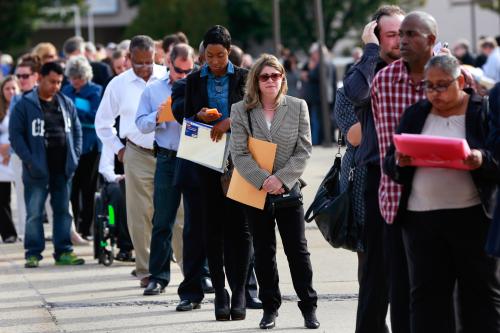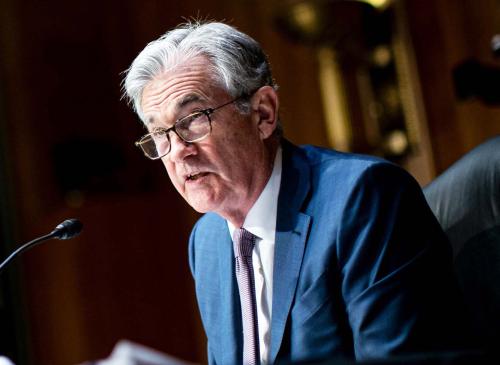The United States Federal Reserve has a dual mandate from Congress: maintain price stability and pursue maximum employment. A new strategy announced in August 2020 by Federal Reserve Chair Jerome Powell called for a more inclusive employment mandate aimed at boosting employment for workers in low- and moderate-income communities, often people of color. This is in keeping with the Fed’s response to the pandemic’s effect on the economy, which has used aggressive bond purchases and other tools to keep the labor market as tight as possible, thereby preventing a landslide into recession-level unemployment.
However, as fears of inflation increase, we are at a possible inflection point regarding the future of this strategy. In August 2021 consumer prices increased 5.3 percent before seasonal adjustment year over year. June 2021 saw the biggest monthly gain in consumer prices, 5.4 percent, since August 2008, which translated into negative real wages for workers. This rise in inflation likely reflects temporary supply chain disruptions and the uneven reopening of sectors such as hospitality due to the ongoing pandemic. But inflation could linger longer than initially expected and even potentially increase. And while the Fed publicly maintains that current inflation is not a pressing concern (perhaps to not spook Wall Street), private doubts might lead the Fed to reconsider its approach.
One foreshadowing of a potential change in policy occurred in a press conference held after the most recent Fed meeting on September 22. During the conference, Chairman Powell noted that in his view, and that of many on the committee, there has been enough progress in employment metrics that the Fed will likely soon consider tapering off its bond purchases, thereby cooling inflation and producing a slacker labor market.
But employment gains for whom? When a journalist asked Powell “if a 6.1 percent unemployment rate for African-Americans is consistent with full employment or whether it would need to be lower as part of your inclusive-growth strategy,” Powell hedged his response: “We have, you know, famously broad and blunt tools. I think eliminating inequality and racial discrimination and racial disparities and that kind of thing is really something that fiscal policy and other policies, frankly—education policies and that kind of thing—are better at focusing on.”
This response sidelines the issue of stark racial disparities in employment which need to be explicitly addressed by the Fed. The Bureau of Labor Statistics August jobs report showed little improvement in employment from July, but an increase in the unemployment rate for Black workers. During the three-month period between June and August 2021, the Black unemployment rate has averaged 3.2 percentage points higher than the U.S. unemployment rate, while the white unemployment rate has averaged 0.7 percentage points lower. Black teens had the highest average unemployment rate during this period, 13.5 percent, compared to 13 percent for Latino or Hispanic teens, and 8.9 percent for white teens. Black women make up about 8.5 percent of the U.S. workforce, but accounted for more than 12 percent of the decline in employment since February 2020. And at the metro level, during the three-month period between June and August 2021, about half of local minority groups tracked by Bloomberg experienced significantly higher unemployment levels than the same period in 2019, prior to the pandemic.
Creating slack in the labor market now would be a huge mistake. To do so would allow unemployment to persist for Black workers and communities (who were most impacted by the pandemic), and it would also undermine the ability of all workers (especially those in the low-wage service industry) to leverage their power to receive higher wages and better working conditions. While it is important to closely monitor inflation trends and to change course if evidence shows inflation is structural not transitory, it is not worth cementing current racial employment disparities by tightening monetary policy due merely to fear of what future inflation might look like.
The empirical case for tight labor markets
The observation that tight labor markets produce socially beneficial results is not new. The late Arthur Okun, a renowned economist and former fellow here at Brookings, advanced this same argument several decades ago. In what is known as Okun’s Law, a one percent increase in unemployment is associated with a two to three percent decrease in GDP.
In a Brookings paper, Okun called the unemployment rate “the tip of the iceberg.” The rest of the iceberg includes: “(a) additional jobs for people who do not actively seek work in a slack labor market but nonetheless take jobs when they become available; (b) a longer workweek reflecting less part-time and more overtime employment; and (c) extra productivity more output per manhour-from fuller and more efficient use of labor and capital.” Thus, unemployment has sharp economic costs while increasing employment offers substantial economic gains.
Okun’s insights continue to animate economic discussions. A recent publication included in the 2019 Brookings Papers on Economic Activity revisits Okun’s Law using post-recession economic data. The authors find, “When the labor market is already strong, a further increment of strengthening provides some extra benefit to some disadvantaged groups, relative to earlier in the labor market cycle.” The authors also find evidence that these gains are persistent, especially for certain groups including Black and female workers.
Likewise, an analysis by our colleagues at The Hamilton Project of recent historical data finds evidence that racial unemployment gaps “narrow during economic expansions within each business cycle, as the labor market tightens, and rise sharply during economic downturns.” This analysis also finds that tight labor markets boosted wages, particularly for low-income workers, without causing jumps in inflation.
Finally, these findings also mirror those found in a recent Economic Policy Institute analysis on the dramatic effects of high-pressure labor markets on racial wage gaps. That report finds that 1% and 2% declines in unemployment rates could substantially lower racial wage and income gaps.
This research makes clear that the Fed has a vital and ongoing role to play in reducing racial inequities as part of their mandate in pursuing full employment. If the Fed truly cares about its inclusive strategy, it should continue to prioritize the social and economic gains of a tight labor market even as the aggregate economy returns to pre-pandemic levels.
The future of the Fed
President Biden is expected to soon announce whether he will renominate Powell to chair the Fed. This impending decision has revealed splits among Democrats, with some arguing that Powell should be replaced by a progressive committed to stricter banking regulation and divestment from fossil fuel industries, while others support Powell with the hopes that he could garner bipartisan support for Biden’s policy agenda.
But regardless of what Biden decides, it is imperative that the inclusive strategy remains a pillar, and that the Fed prioritizes racial justice and the interests of labor by ensuring labor markets remain tight. We have too much to lose by letting fear of future runaway inflation hold us back. And we have so much to gain from a world where full employment with fair wages and humane working conditions is a reality for all workers, regardless of their race and gender.
The Brookings Institution is committed to quality, independence, and impact.
We are supported by a diverse array of funders. In line with our values and policies, each Brookings publication represents the sole views of its author(s).








Commentary
Fed should keep labor markets tight for a more inclusive economy
October 13, 2021